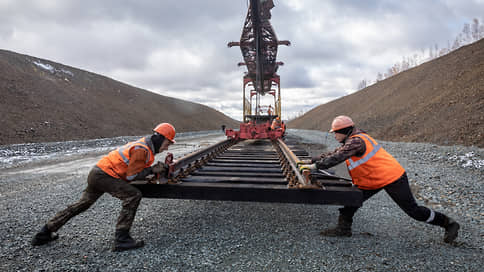The reasons for the delay at BAM were picked up – Newspaper Kommersant No. 11 (7456) dated 01/23/2023
[ad_1]

Russian Railways is discussing making adjustments to the second stage of the expansion of the BAM and the Trans-Siberian. We are talking about reducing work in the eastern part of the BAM, but increasing the capacity in the area of the Nizhneleninskoye-Tongjiang border crossing. Nominally, the capacity of the Komsomolsk-Vanino section should fall by 24 million tons compared to the plan, but Russian Railways emphasizes that the real reduction will be less than 9 million tons, and the original plan will lead to restrictions on the same volume due to construction work. Consumers consider it more effective to shift the timing of the electrification of the eastern BAM.
The Council of Consumers of JSC Russian Railways drew up an expert opinion on the adjustments proposed by the monopoly for the second stage of the modernization of the BAM and the Trans-Siberian Railway, which provide for a shift in work on the eastern sections of the BAM with compensation for them through the development of approaches to the Nizhneleninskoye-Tongjiang border crossing in the JAO and the ports of Primorye. Kommersant talked about the essence of these events on December 12, 2022.
Now the second stage involves the implementation of 263 facilities and the achievement of 180 million tons of carrying capacity by the end of 2024. In the current configuration, before adjustments, the volume of activities in 2023 is 138 facilities and 173 million tons at the end of the year. It is proposed to adjust the timing of work at two sections: Komsomolsk-Sortirovochny-Vanino and Volochaevka-Komsomolsk-Sortirovochny, with the transfer of commissioning of 14 facilities from 2024 to 2025 and two electrification facilities to 2028. As a result, the carrying capacity of these two sections will decrease from 80.1 million to 57.7 million tons.
The Council of Consumers in its conclusion points to a decrease in the carrying capacity on the Komsomolsk-Vanino section by 24 million tons, the justification for which is not available in the materials of the monopoly. But, says one of Kommersant’s sources, Russian Railways indicated that the reduction to 57.7 million tons should be considered taking into account the estimated freight traffic approved by the Ministry of Transport in 2021 – 66.3 million tons.
Thus, there is a shortage of carrying capacity of 8.6 million tons, which can be redirected to the Nizhneleninskoye-Tongjiang border crossing (3.4 million tons) and the ports of Primorsky Krai (5.2 million tons). To this end, it is proposed to introduce eight new facilities in the Novy Urgal-Izvestkovaya section. Thus, in total, in the second stage there will be 255 objects instead of 263, of which 142 objects should be put into operation in 2023.
The Consumer Council notes that if the reduction in work is associated with a funding gap, then it can be minimized by agreeing to the transfer of the electrification of the Volochaevka-Komsomolsk-Vanino sections proposed by Russian Railways for 2026-2028, which will free up about 107 billion rubles. At the same time, it is necessary to ensure the maximum possible preservation of the terms for the construction of second tracks in the Komsomolsk-Vanino section.
At a meeting with the Council of Consumers, representatives of Russian Railways, says a Kommersant source, stressed that the transfer of most facilities is planned for only a year. The goal is to reduce the funding gap in 2024–2025 and optimize construction and labor resources. At the same time, the carrying capacity of 180 million tons by the end of 2024 will be achieved, they assured, noting that they are ready to work according to the basic option. But without adjustments, as a result of the implementation of the second stage on the Komsomolsk-Vanino section, an excess of carrying capacity of 16 million tons is formed, while a deficit remains on the Ulak-Komsomolsk section. In addition, without adjustments, construction work begins to interfere with the passage of goods – in the Komsomolsk-Vanino section, losses can amount to 5-7 million tons, representatives of Russian Railways reported.
Kuzbass did not agree with the adjustment. His representative, says the interlocutor of Kommersant, noted that mainly Kuzbass coal is transported through Vanino, therefore it is Kuzbass that will suffer the greatest losses from the coal-mining regions. Representatives of the Consumer Council noted as new information that there is a conflict between construction and the transport of goods, the interlocutor of Kommersant says, and following the meeting, the parties agreed to analyze all the data again. No final decisions were made. Russian Railways told Kommersant that discussions are ongoing and decisions will be made jointly, taking into account the opinions of all interested parties.
According to Mikhail Burmistrov, head of Infoline-Analytics, Russian Railways presents a coherent argumentation, however, due to the fact that only a monopoly has a complete picture, it is difficult not only for shippers, but also for authorities to assess the objectivity of these factors. In his opinion, control over the construction of JSC Russian Railways has recently been noticeably increased, so now the company is trying to minimize the risks of non-fulfillment of its obligations by postponing the commissioning of facilities for which there are high risks of not meeting the plan, even if these facilities are key from the point of view of growth of carrying capacity in certain sections.
JSC Russian Railways, the expert notes, judging by the results of 2022 and plans for 2023, is gradually providing debottlenecking and increasing the carrying capacity of the Eastern landfill, however, it is difficult to separate the result of organizational and technological measures from the contribution of the constructed and commissioned facilities.
[ad_2]
Source link





